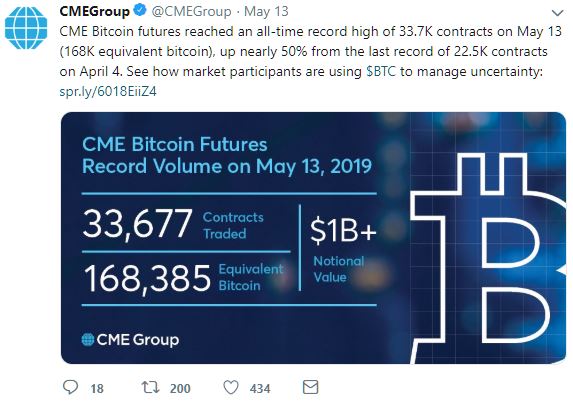By CCN: After nearly 18 months of operation, the Cboe bitcoin futures market is closing for good, or at least for the foreseeable future, with the expiration of its last bitcoin futures contract on June 16.
Speaking to Bloomberg, Cboe spokeswoman Suzanne Cosgrove revealed that the company does not have plans to release a new product for cryptocurrency trading at this time, reaffirming the closure of its bitcoin futures market that was announced in March.
“[Cboe] is assessing its approach with respect to how it plans to continue to offer digital asset derivatives for trading, but we have nothing new to announce at this time,” Cosgrove said.
But, the closure of the Cboe bitcoin futures market is unlikely to have a major impact on the price trend of the dominant cryptocurrency because of the wild success of crosstown rival CME Group.
CME Posts Record-High Bitcoin Trading Volumes
Under Terry Duffy’s watchful eye, CME has quietly carved out a sizable share of the global bitcoin trading market. | Source: Michael Reaves / Getty Images / AFP
On May 13, CME Group reached a record high volume of 33,700 contracts for bitcoin, processing more than a billion dollars in a single day.
As reported by global markets analyst Alex Krüger, bitcoin has been the second most heavily traded asset at CME based on volume/open interest earlier this month, indicating that the demand for the asset by accredited investors and institutions remains high.
Krüger said:
“Bitcoin is the second most heavily traded asset at the CME when measured by the volume / open interest ratio. In other words, bitcoin is an asset very actively traded throughout the day.”
“Volume is the number of contracts traded in a day, while open interest is the number of outstanding contracts held (unsettled) at the end of the day. A high ratio points towards market participants actively trading intraday for whatever reason (hft, arbitrage, etc).”
Based on the research of Bitwise Asset Management, when fake volume in the bitcoin exchange market is removed, the futures market including both CME and Cboe accounted for a relatively large portion of the global BTC volume.
Following the decline in the demand for the Cboe bitcoin futures contract and the rise of CME, most of the futures volume in the U.S. market shifted to CME.
In late March, when the price of bitcoin was hovering at around $4,000 supplemented with low volume, Bitwise disclosed that the CME bitcoin market, which is regulated and transparent, accounts for 35 percent of the real spot volume of the asset.
“And, when you remove fake volume, CME and CBOE futures volume is significant ($91M), especially compared to the real spot volume (35% for Feb 2019). This is good news because it means CME— a regulated, surveilled market— is of material size, which important for an ETF,” the investment firm said.
CME took over the U.S. market, driving significant interest from accredited investors. When Cboe announced the closure of its bitcoin futures market, it traded around $8 million in contracts. In contrast, CME settled $90 million, more than 11-fold of Cboe’s daily volume.
Cboe’s Futures Exit Is Not an Indictment of the Crypto Market
The decision of Cboe to move out of the bitcoin market likely has less to do with its prospect of the trend of the crypto market than the strong growth of its rival CME and the rapidly changing blockchain landscape.
Hence, with CME in place and new institutional platforms like Fidelity and Bakkt coming online, the bitcoin market is still in an ideal position to maintain its momentum throughout the medium term.





